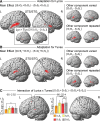The relationship of lyrics and tunes in the processing of unfamiliar songs: a functional magnetic resonance adaptation study
- PMID: 20219991
- PMCID: PMC6632242
- DOI: 10.1523/JNEUROSCI.2751-09.2010
The relationship of lyrics and tunes in the processing of unfamiliar songs: a functional magnetic resonance adaptation study
Abstract
The cognitive relationship between lyrics and tunes in song is currently under debate, with some researchers arguing that lyrics and tunes are represented as separate components, while others suggest that they are processed in integration. The present study addressed this issue by means of a functional magnetic resonance adaptation paradigm during passive listening to unfamiliar songs. The repetition and variation of lyrics and/or tunes in blocks of six songs was crossed in a 2 x 2 factorial design to induce selective adaptation for each component. Reductions of the hemodynamic response were observed along the superior temporal sulcus and gyrus (STS/STG) bilaterally. Within these regions, the left mid-STS showed an interaction of the adaptation effects for lyrics and tunes, suggesting an integrated processing of the two components at prelexical, phonemic processing levels. The degree of integration decayed toward more anterior regions of the left STS, where the lack of such an interaction and the stronger adaptation for lyrics than for tunes was suggestive of an independent processing of lyrics, perhaps resulting from the processing of meaning. Finally, evidence for an integrated representation of lyrics and tunes was found in the left dorsal precentral gyrus (PrCG), possibly relating to the build-up of a vocal code for singing in which musical and linguistic features of song are fused. Overall, these results demonstrate that lyrics and tunes are processed at varying degrees of integration (and separation) through the consecutive processing levels allocated along the posterior-anterior axis of the left STS and the left PrCG.
Figures



Similar articles
-
Neural substrates for semantic memory of familiar songs: is there an interface between lyrics and melodies?PLoS One. 2012;7(9):e46354. doi: 10.1371/journal.pone.0046354. Epub 2012 Sep 28. PLoS One. 2012. PMID: 23029492 Free PMC article.
-
Song and speech: brain regions involved with perception and covert production.Neuroimage. 2006 Jul 1;31(3):1327-42. doi: 10.1016/j.neuroimage.2006.01.036. Epub 2006 Mar 20. Neuroimage. 2006. PMID: 16546406
-
Neural correlates of binding lyrics and melodies for the encoding of new songs.Neuroimage. 2016 Feb 15;127:333-345. doi: 10.1016/j.neuroimage.2015.12.018. Epub 2015 Dec 17. Neuroimage. 2016. PMID: 26706449
-
Towards a neural basis of processing musical semantics.Phys Life Rev. 2011 Jun;8(2):89-105. doi: 10.1016/j.plrev.2011.04.004. Epub 2011 Apr 29. Phys Life Rev. 2011. PMID: 21601541 Review.
-
Using science songs to enhance learning: an interdisciplinary approach.CBE Life Sci Educ. 2012 Spring;11(1):26-30. doi: 10.1187/cbe.11-08-0068. CBE Life Sci Educ. 2012. PMID: 22383614 Free PMC article. Review.
Cited by
-
How the Brain Understands Spoken and Sung Sentences.Brain Sci. 2020 Jan 8;10(1):36. doi: 10.3390/brainsci10010036. Brain Sci. 2020. PMID: 31936356 Free PMC article.
-
Perception of words and pitch patterns in song and speech.Front Psychol. 2012 Mar 19;3:76. doi: 10.3389/fpsyg.2012.00076. eCollection 2012. Front Psychol. 2012. PMID: 22457659 Free PMC article.
-
Evolution of tonal organization in music mirrors symbolic representation of perceptual reality. Part-1: Prehistoric.Front Psychol. 2015 Oct 16;6:1405. doi: 10.3389/fpsyg.2015.01405. eCollection 2015. Front Psychol. 2015. PMID: 26528193 Free PMC article.
-
Singing can facilitate foreign language learning.Mem Cognit. 2014 Jan;42(1):41-52. doi: 10.3758/s13421-013-0342-5. Mem Cognit. 2014. PMID: 23860945 Clinical Trial.
-
Functional neural changes associated with acquired amusia across different stages of recovery after stroke.Sci Rep. 2017 Sep 12;7(1):11390. doi: 10.1038/s41598-017-11841-6. Sci Rep. 2017. PMID: 28900231 Free PMC article.
References
-
- Belin P, Zatorre RJ. Adaptation to speaker's voice in right anterior temporal lobe. Neuroreport. 2003;14:2105–2109. - PubMed
-
- Belin P, Zatorre RJ, Lafaille P, Ahad P, Pike B. Voice-selective areas in human auditory cortex. Nature. 2000;403:309–312. - PubMed
-
- Besson M, Faïta F, Peretz I, Bonnel AM, Requin J. Singing in the brain: independence of lyrics and tunes. Psychol Sci. 1998;9:494–498.
-
- Bigand E, Tillmann B, Poulin B, D'Adamo DA, Madurell F. The effect of harmonic context on phoneme monitoring in vocal music. Cognition. 2001;81:B11–B20. - PubMed
-
- Binder J. The new neuroanatomy of speech perception. Brain. 2000;123:2371–2372. - PubMed
Publication types
MeSH terms
LinkOut - more resources
Full Text Sources
Medical
